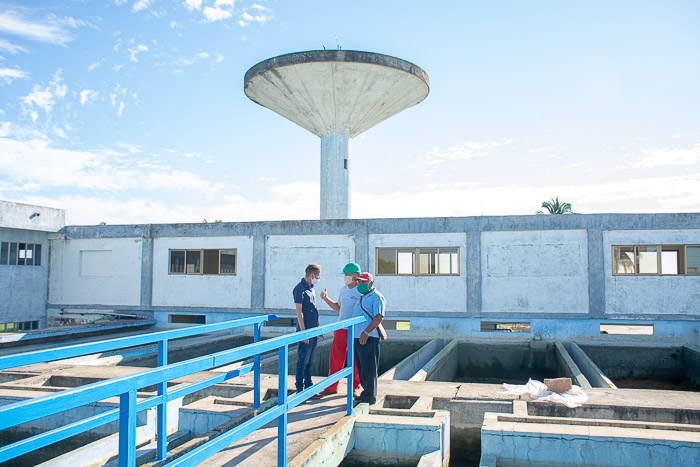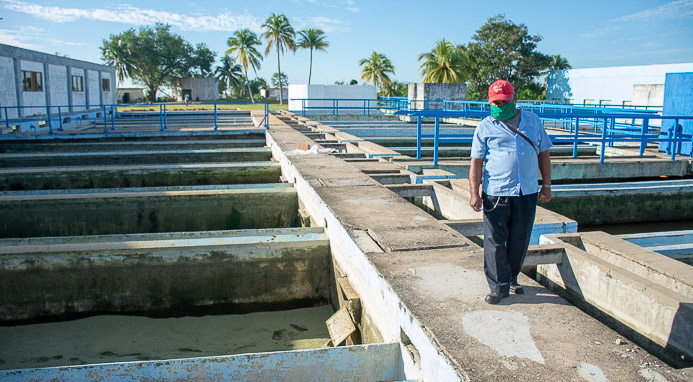CAMAGÜEY.- The engineer Luis Palacios Hidalgo, graduated as a medium-level technician in irrigation and drainage in the plans of Camagüey's Agriculture, never thought that his life would be marked forever on the drinking water of his extensive province, preceded by the main headquarters in the Southern Hydraulic Complex, Aqueduct and Sewerage, the Territorial Engineering Services Company (Ciego de Ávila-Camagüey-Las Tunas) ... until he was director of the projects and loans agreed with the Saudi Fund for Development.
At a meeting on the quality of drinking water - a few years ago - this specialist from the National Institute of Hydraulic Resources (INRH) in Camagüey, asked to speak, raised a transparent bottle of water from the "shopping" (as Cubans call currency stores) to ensure that when the inhabitants served by the aqueduct received a similar liquid, then the results of so many efforts by many generations of workers in the sector would be recognized.
And although even for him that proposal seemed a total utopia, an impossible dream, today the implausible sentence is closer and closer to reality.
Regarding the stages of this credit support that the INRH, Cuba as a country, executes and pays as agreed with the international financing fund and the Government in Camagüey, he stated:
“For the first stage, we agreed to 40 million dollars, the realization of which not only includes the modernization and start-up of the third water treatment module of the Cuban-Bulgarian water treatment plant in the city of Camagüey. It also includes the repair and construction of 72 kilometers of new conduits and 45 of networks, the rehabilitation of the pumping stations to ensure that from the main supply reservoirs, Máximo and Cubano-Búlgara, 1 800 liters of water reach the plant per second and the other historical source of provision to the Camagüey's population, Pontezuela, with improvements in all its civil and technological infrastructure, remains in reserve of this vital socio-economic service system ”.
-When does this first stage conclude?
—We hope it will be at the end of March 2021, when the new conductors of the Máximo and Cubano-Búlgara dams will reach the water treatment plant in a sustained and stable manner at 1,800 liters per second —a capacity established for treatment in the three modules in functioning. Then we can ensure the volume demanded, continuous service to the population with fewer losses due to leaks and breakdowns and the water will have better quality after the chemical-bacteriological process conceived.

SECOND STAGE, BEYOND THE PROVINCIAL CAPITAL
During the second phase, the vital benefit project, mainly for human health, will continue to be achieved with the improvement of the supply systems to the city of Camagüey, in parallel with the waste treatment.
This implies the termination or tie of the conduit of the Máximo dam at the Altagracia junction to the water treatment plant through a 1,000-millimeter diameter plastic conduit; 154.4 kilometers of new distribution networks and 24.4 km of collectors and marginal areas to evacuate the wastewater that today enters city rivers without treatment.
The prospect of drinking water will transcend beyond the provincial capital of Camagüey, it will extend and benefit the inhabitants of the cities of Nuevitas and Florida.
"This is how the second part of the proposed loan with the Kingdom of Saudi Arabia is projected, equivalent to about 45 million dollars for the hydrometric sectorization of the provincial capital with home and volumetric meters, new valves and 75 kilometers of pipes, among other actions" .
-What will it be like in Nuevitas?
—There the civil construction and technological equipment of the water treatment plant are completely rehabilitated to bring it to the original design and process 600 liters per second of drinking water in its two modules; recover, in addition, the raw water pumping station with the repair and construction of conduits and distribution networks in the so-called industrial city, which will benefit around 40,000 consumers.
Palacios Hidalgo explained that in the third city of provincial priority, thousands of Florida's inhabitants will be able to consume higher quality water through an old unfinished project that starts from the rehabilitation of four mighty wells in San Antonio, to lead it through a pipeline of 800 millimeters in diameter and a length of approximately 26.3 kilometers and the construction of two supported tanks with a capacity of 5,000 cubic meters, plus a station for regulated pumping.
With this, most of the citizens of that town would stop drinking drinking water, but not treated, raw, from the Caonao reservoir, whose source will be preserved as emergency support to the city of Camagüey in the event of a prolonged drought, as has already happened in the past.
The INRH specialist in the province highlighted that the negotiations of the proposal for the achievement of the second stage of the humanitarian hydraulic project continue, while the forces and means of the agency it represents, despite the shortages of the brutal blockade and siege of the United States and the economic consequences of the pandemic are not stopping.
With the available resources, they not only finish objects and hydraulic works of the first stage, but also clear projects and create advanced conditions to undertake with quality the designs planned for the second stage.
Translated by Linet Acuña Quilez



